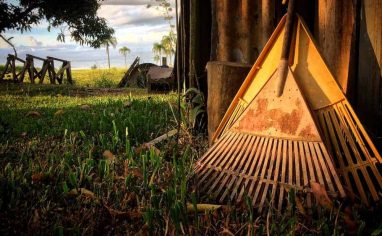
If you are reading this resource, you are likely a compassionate individual who wants to create a better world. Operating a sustainable sanctuary for farmed animals certainly makes a big difference in the lives of those animals, and can go far in creating a more caring world for all of us! Of course, like many things we do, operating a sanctuary generates waste and requires many resources, like a reliable power supply and water. The good news is there are a number of things you can do to create a more environmentally-friendly sanctuary!
Use Recycled Paper Products
Running a sanctuary often requires the use of a copious amount of paper towels, toilet paper, office paper, business cards, and educational materials. Try to purchase products that are made from recycled paper or sustainable sources. Printing on recycled paper rather than virgin paper lessens resource utilization and the environmental impacts related to forestry, landfilling waste paper, and the production of paper from virgin pulp.
Beyond the purchase of more sustainable products, reusing and recycling paper at your organization reduces the amount of waste in landfills and reduces the production of methane from waste decomposition. Need to print something? Use the front and back! Keep a stack of paper that has been printed on one side at the ready near your printer.
Salvage Building Materials
While this may not always be possible, if you have the luxury of time, salvaging building materials can have a positive impact on the environment and on your budget. Reclaimed lumber in some cases is better than the new lumber you can get from the lumber yard. It has been air dried over many years, making it much more stable. Salvaging old barn wood ensures it doesn’t end up in a landfill and reduces the demand for new lumber. You can also find sinks, hardware, doors, fencing, and many other supplies that could be of use at a sanctuary.
If you are utilizing any reclaimed wood in areas where residents have direct access to the material, such as fencing or stall doors, you must ensure that it hasn’t been treated with any kind of stain or chemical that is not safe for any curious residents to nibble on!
Request Donations Of Old Tools, Equipment, And Supplies
You may be surprised how many supporters may have an old power tool, extra shovel, or even an old pickup truck they may be willing to donate. If you have such a need, try sending out a request for donations on social media and through email lists, as well as on your website.
If you are a registered 501(c)(3) nonprofitA non-governmental organization whose primary purpose is something other than selling goods or services. in the United States, these in-kind donations can be tax deductible, making the request for donations more attractive to potential givers.
Increase Energy Efficiency
Most likely, some of your sanctuary needs will require power. Here are several ways you can increase energy efficiency at your sanctuary:
- Replace light bulbs with more efficient bulbs, such as LEDs (while keeping fire safety in mind!)
- Install timers or motion sensors in security lighting systems and in low-traffic areas
- Purchase appliances that are ENERGY STAR certified
- Turn computer monitors off when not in use, or set all computers to enter power saving mode after a short period of time
- Insulate and tint glass windows to retain heat in during the winter and to keep the heat out during the summer
- Unplug electrical devices when they are not in use, or use power saving auto-off plugs
You need good lighting to perform many of the duties required at a sanctuary. Taking advantage of existing natural light can help reduce electricity usage, especially if rooms can be reconfigured to maximize sunlight from windows. And consider integrating skylights into future structure and living spaceThe indoor or outdoor area where an animal resident lives, eats, and rests. designs!
Reduce Waste Production And Improve Waste Management
While it may be difficult to entirely eliminate waste, there are a number of ways you can greatly reduce the amount of waste at a sanctuary. In addition to being mindful of waste brought on-site in the first place, you can develop ways to manage unavoidable waste that are more environmentally-friendly:
- Learn about waste disposal and recycling programs in your community, especially hard-to-recycle items like plastic bags and films, electronics, and hazardous materials
- Get staff involved in a sanctuary recycling and composting program
- Ensure all staff know how to properly dispose of all waste
- Use recycled office products where possible, including paper products, glass, and aluminum
- Install recycling, trash, and compost bins (as allowed by local law), and create clear signage about what goes into what bin
- Request that your suppliers minimize packaging materials
Improve Water Efficiency
As you may know, residents can consume quite a lot of water every day. Cleaning also requires a lot of water. Consider the following tips to improve water efficiency at your sanctuary:
- Landscape with drought resistant, resident-safe non-toxic plants
- Install low-flow water fixtures for faucets as well as low-flow or dual flush toilets where practical
- Use a filtered pitcher for drinking water or install a drinking station instead of using bottled water
- Harvest rainwater for cleaning. (Be sure to check if it is legal to capture in your region)
- Invest in auto-watering systems for residents that automatically replenish when they run low
Convert To Solar Power
Converting to a renewable energy source promotes sustainable living practices to visitors and nearby communities, and helps to reduce the costs of running and maintaining your facilities. You may even be able to find grants to help you cover the cost of installing solar at your sanctuary.
If you are considering solar or wind power at your sanctuary, it is important to use wildlife-friendly techniques!
Utilize Eco-Friendly Cleaning Products
When practical, use eco-friendly cleaning chemicals for stall clean-outs, windows, surfaces, floors, and laundry.
Seek Out Produce Donations
Contact your local grocer and ask about their unsellable produce. Some grocers will donate produce that can no longer be sold to humans. Also, don’t forget to check and see if there are any cut fruit gift basket stores in your area (like Edible Arrangements). They often have fruit scraps that may be considered garbage to them but a tasty treat for some lucky residents. Some sanctuaries are able to schedule produce pick-ups with these businesses. This saves the food from rotting in a landfill while providing residents with appropriate treats and nutrients.
A Festive Treat
The fall is another great time of year to get produce, when folks are getting rid of pumpkins. Some sanctuaries set up a pumpkin drop-off day, when the public can bring in their old pumpkins. Some pumpkin farms have also been known to donate good pumpkins after Halloween.
Staff must inspect the pumpkins, and if they are still in good shape and not rotting, they can be fed to certain residents. In addition to avoiding mold, it’s important to avoid feeding any pumpkins or scraps that have ink on them from Jack-O-Lantern carving projects! Conducted mindfully, a pumpkin program can be a fun enrichment opportunity and a chance to build relationships with the community without promoting harm.
Not all produce is right for every resident. Check what produce you can safely give to residents like chickens, goats, and sheep!
Encourage Carpooling
Encourage staff and volunteers that live near each other to carpool if convenient for them. You can facilitate this by creating a ride-share spreadsheet for volunteers and staff, where they can sign-up and find a carpool companion if they would like to participate. Sanctuaries can also create a reward system or raffle to encourage participation.
Create A Pollinator-Friendly Landscape
If you decide to landscape the sanctuary property, consider choosing plants that provide habitats and food for pollinators like the native bees that could use our support. Are there difficult areas to mow? Replant that area with flowers and shrubs. Avoid the use of pesticides.
One Step At A Time
It’s okay to start small. Even implementing one of these suggestions helps a little. Put in recycling bins or purchase more efficient light bulbs. Make a plan to put more of these eco-friendly suggestions into practice over time. And tell your community about your commitment to help the planet while you help your residents!
Infographic
Looking to share this information in an accessible way with other sanctuaries and supporters? Check out and share our infographic below!
Tips for eco-friendly by Amber D Barnes
SOURCES:
Eco-Friendly Animal Shelters | One Green Planet
Greening Animal Shelters | The Bark
How To Harvest Rainwater In Your Garden | Happy DIY Home
Growing Landscapes To Help Bees And Other Pollinators | University Of Minnesota Extension
Options For Integrating Eco-Friendly Features Into Veterinary Practices | American Veterinary Medical Association








